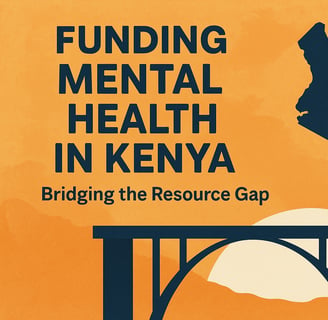Funding Mental Health in Kenya: Bridging the Resource Gap
Kenya’s young people are experiencing unprecedented levels of stress, anxiety, and depression—yet the resources devoted to mental health remain woefully inadequate. In this post, we explore the current funding landscape, the consequences of underinvestment, and practical pathways to close the gap.
5/27/20252 min read


Current Budget Realities
Less Than 1% Allocated: Despite the 2019 Mental Health Act’s promise, mental health still receives under 1% of Kenya’s national health budget. This translates to minimal staffing, outdated facilities, and scarce community programs.
Cost Barriers for Families: A single private counseling session can cost Ksh 2,000–3,000, putting professional help out of reach for most households. Without subsidized options, many children never get the support they need.
2. The Human Toll of Underfunding
Late-Stage Interventions: Schools and clinics often wait for crises—self‑harm, school dropouts, or hospitalization—before allocating scarce counseling hours.
Regional Disparities: Urban centers like Nairobi have at least one psychiatrist per 50,000 people; some rural counties have none. Students in these regions face months‑long waits or must travel long distances.
Lost Potential: Untreated mental health issues contribute to declining academic performance, increased absenteeism, and long‑term socioeconomic impacts.
3. Emerging Funding Models
Public–Private Partnerships: Collaborations between county governments, NGOs, and private clinics can pool resources to establish satellite counseling centers in underserved areas.
School‑Embedded Budgets: By integrating mental health costs (e.g., our Ksh 1000/term per student model) directly into school fees, institutions gain predictable revenue to hire full‑time counselors and subscribe to digital screening tools.
Impact Investing & Social Bonds: Investors seeking both financial return and social good can back “mental health bonds,” where repayment is tied to measurable improvements in student well‑being and reduced crisis incidents.
4. Leveraging Technology for Cost‑Effectiveness
Digital platforms dramatically lower the per‑student cost of screening and monitoring.
Economies of Scale: Once developed, an AI‑driven screening tool can be deployed to tens of thousands of students at minimal incremental cost.
Remote Supervision: Tele‑counseling and online training modules reduce the need for every facility to hire multiple specialists locally.
Data‑Informe1 Budgeting: Real‑time dashboards help schools and counties allocate funds where they’re most needed—turning guesswork into evidence‑backed decisions.
5. Call to Action: A Shared Responsibility
Closing Kenya’s mental health funding gap requires concerted effort:
Government Leadership: Increase the mental health line item to at least 3–5% of the health budget, as recommended by the World Health Organization.
School Commitment: Embed mental health costs into annual school planning, ensuring every student gains access to affordable screenings and support.
Private Sector & Donors: Channel corporate social responsibility funds and donor grants into sustainable programs, not one‑off pilots.
Community Engagement: Parents, teachers, and students themselves must advocate for dedicated mental health resources in county assemblies and school boards.
By innovating our funding models and embracing cost‑effective technology, we can transform mental health from a luxury into a fundamental right for Kenya’s youth. Let’s invest in resilience today, so our students can flourish tomorrow.
Student well-being
Transforming student well-being through innovative solutions.
Contact us
BeFiti ©2025. All rights reserved.
